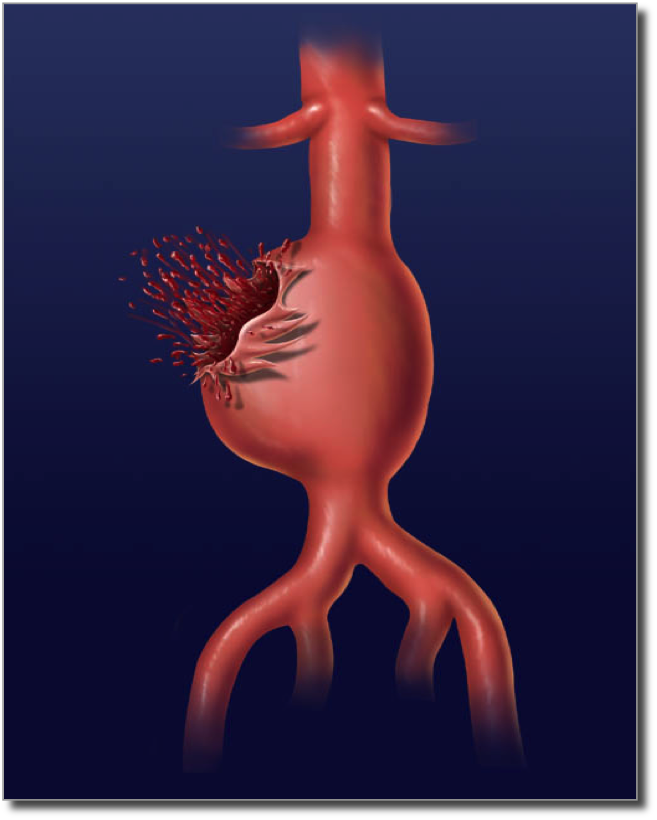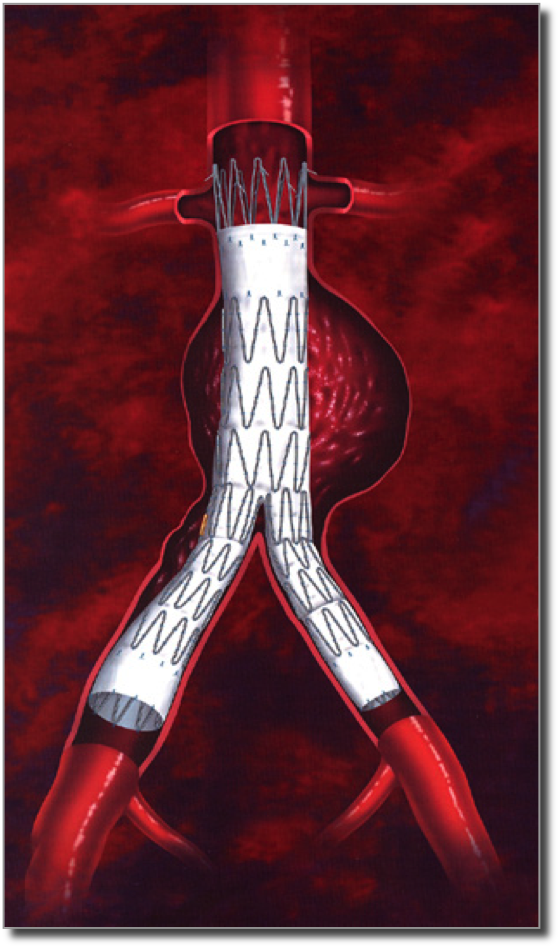Magic with Stents
From the Desk of Dr. Wheatley
Subj: Abdominal aortic stents
What is an aortic stent-graft and how does it work?

Before we answer that question, we will need to revisit a discussion of the relevant anatomy.
Abdominal aortic aneurysms are an unusual health problem. They have been called “silent killers”. They lurk deep inside the abdomen (stomach region) and grow without warning and can strike at any time.
One of the reasons that they are silent is because they develop in a region of the abdomen which is behind all of the abdominal contents and organs - called the retroperitoneum.
As the aorta enlarges in this location there is a lot of space for the aneurysm to expand without directly affecting any vital structures.
The abdominal aorta, as you recall, is located roughly at the level of the belly button (navel) and deep internally by the spine.
The aorta concludes by dividing into the left and right iliac arteries. These arteries supply blood flow to the legs.

Preceding the aortic bifurcation are the arteries to the kidneys (renal arteries). There are 2 kidneys, left and right, and each kidney usually has a single dedicated blood vessel.
The distance between the branches of the kidney arteries and the branching of the aorta is approximately 5 inches. In this 5 inch segment of the aorta, abdominal aortic aneurysms (AAA), develop.
Endovascular aneurysm repair (EVAR)
Endovascular techniques have been developed to repair AAAs in a less invasive method. This procedure is also abbreviated EVAR (Endovascular Aneurysm Repair).
These techniques involve inserting an aortic stent-graft inside the aorta which contains the blood flow and takes the pressure off the aorta.
The design of the aortic stents can vary. There are several manufacturers of aortic stents which have engineered different solutions.
Basic components of aortic stents

Fabric - all the stents have material which is used to contain the blood flow inside the stent. The fabric is non-porous, meaning that blood flowing through the aortic stent stays within the fabric and doesn’t get outside the stent.
The types of materials used for the fabric can vary amongst different type of aortic stent graft.
Example of fabrics used in aortic stent grafts are GoreTex and Dacron (which is a woven polyester). The fabrics used in stent-grafts are identical to surgical grafts which are used to surgically replace sections of the aorta and peripheral arteries.

Metal (stent) - A stent is a term which refers to a metal scaffold which is inserted inside the artery. The metal used for aortic stents is frequently nitinol.
This nickel-based alloy has a unique property in that it has a “memory”. What this means is that the way the metal is constructed that no matter what forces bend it or kink it, the metal will always return to its original shape. This property is very useful since stents are crimped into a small sheath in order to deliver them into the blood stream (endovascular).
Proximal and distal seal zones - The seal zones refer to the attachment locations at the top and end of the stent-graft. This is where the stent circumferentially seals against the aortic wall to prevent flowing blood from entering the aneurysm behind the stent.
There are several types of sealing technologies used by stent-grafts.
The first is radial force. Radial force refers to the force exerted by the nitinol metal pushing against the aortic wall. This force is generated by the fact that the diameter of the stent is sized to be larger than the aorta which creates continuous pressure against the aortic wall, leading to a 360 degree complete seal.
The other technology is O ring technology. The O rings are filled with a polymer to create a mechanical seal against the aortic wall. By having this “gasket”-like effect, blood is physically blocked from entering the aneurysm.
![Abdominal aortic aneurysm stent(/images/abdominal-aortic-aneurysm-stent-3.png)
Supra-renal fixation - There is the tendency for the abdominal aortic stents to migrate over time. What this means is that the force of blood being pumped through the aorta create a strong force against the stent.
These forces can lead the stent to slip downward. By including suprarenal metal above the fabric, the migration of the stent can be negated.
The metal extends above the aortic stent-graft, does not have a fabric covering and spans across the openings to the renal arteries.
Modular design - Many of the grafts are designed to be inserted in pieces which ultimately come together inside the aorta to form the final aortic stent-graft product.
The EVAR (endovascular aneurysm repair) procedure involves entering arteries in both groins and through both sides delivering stents into the abdominal aortic aneurysm using X-ray guidance.
The modular components allow customization of the aortic bifurcation. The limbs of the aortic stent-graft are joined inside the body to create a branching which allows blood to flow into both legs.
One stent-graft design is different and has both limbs on the main device, but uses a different technique for insertion and deployment of the aortic stent-graft.
Summary
As you can appreciate, abdominal aortic stents are incredibly complex medical devices which are well-engineered.
Both physicians and patients need to understand the subtle details of the abdominal aortic stents in order to better determine the risks and benefits of these devices and help participate in a joint decision making process about which stent and technique is best. This is an individual decision between patient and physician.
Was this post informative?
Subscribe to my newsletter to learn more about the aorta, its diseases, and how to treat them.
Comments
Share your thoughts below — I try to get back to as many comments as possible.